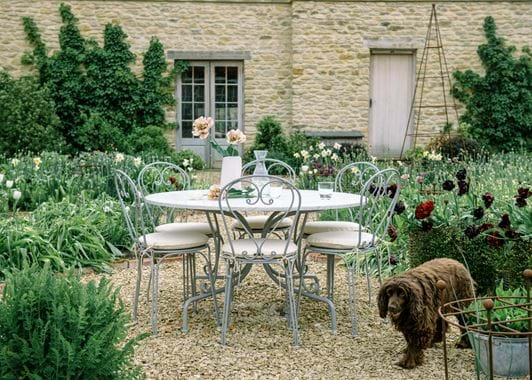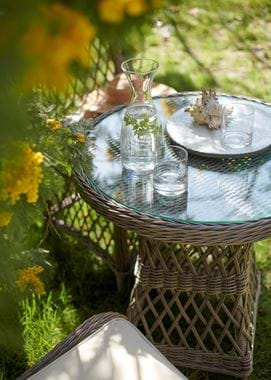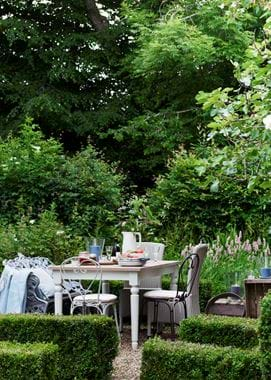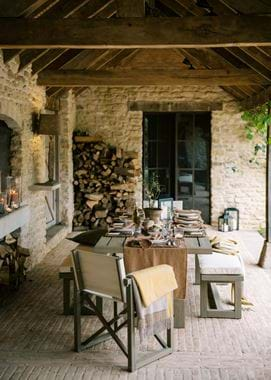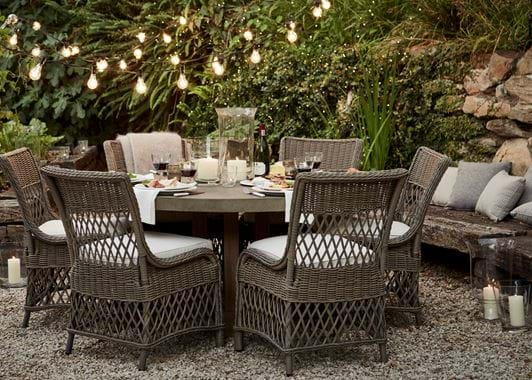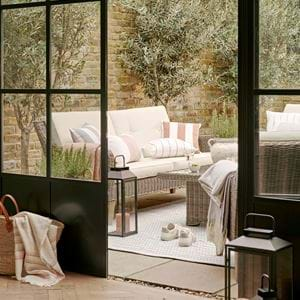How to make outdoor dining work for you
How to make outdoor dining work for you
No sooner does the thermostat start climbing than we’ll all be found rushing outside to take each and every meal under the sun’s rays. Or perhaps not? If your dreams of laidback alfresco dining are as yet unrealised, then read on for our in-depth answers to some of your most-asked garden dining questions, to help you create an outdoor eating space you’ll actually want to use.
I’m looking for low-maintenance dining furniture but don’t want it to feel manmade. What should I choose?
All our garden furniture (with the exception of Chatto, the marble tabletops on Boscombe and anything made from fabric) is happy to weather life outside all year round (although if you can bring it in, so much the better) and is relatively maintenance free. But by far the most easy-going of materials is our all-weather wicker, which really only needs the occasional wash with a hose. It is manmade, but we’ve put a lot of thought and attention into making sure that it doesn’t feel it. There are two colours and textures: one that’s smooth and a darker brown-grey colour, very similar to natural willow; and one that’s lighter in colour and slightly ‘hairy’, so it feels more like woven rattan. Both are strong and sturdy, and not entirely uniform in colour, so they feel the very opposite of an insubstantial, characterless manmade material.
We have two tables in all-weather wicker – the round six-seater and two-seater Harrington designs – and four dining chair styles – Toulston, Stanway, Cayton and Harrington (with the latter two available as both dining and carver chairs) – all of which mix and match well with our teak tables. These too don’t ask for a lot of upkeep, although if you’re worried about the tops staining (especially if your table sits under a tree), you might want to choose the stone and timber Stanway or Hove designs, which you can wipe clean more easily.
It’s worth saying that furniture that’s brought inside over winter will always need less in the way of maintenance to keep it looking good. And if you’re short on storage space, we’d recommend our Denham campaign chairs. As they fold flat, they’re much easier to find room for in your garage or shed. They’re also made from teak with heavyweight outdoor canvas slings (these are a washable, showerproof polyester, although they look and feel just like cotton) so they’re still substantial.
Should I place my outdoor dining area near the house?
A lot of the time, yes, but not necessarily. While it’s true that, especially if it’s your kitchen that looks onto your garden, having your outdoor dining area next to your home is the most practical option, more important would be to consider where the sun falls (and when). So, for instance, if you know that you’ll be using your garden mainly for suppers, you’ll want to choose a spot in your garden (if possible) that benefits from a little evening sun. Likewise, if it’s your morning coffee that you want to enjoy outside, pay attention to the areas that are warmed by the sun then. Perhaps it might even be both, in which case it could be worth thinking about two eating areas: a smaller one with a two-seater set like Boscombe for solitary breakfasts, and a larger table that all the family can gather around at the end of the day.
In contrast, if it’s lunches that you’ll be taking alfresco, you may want to consider a shadier spot instead, as the summer sun at the high point of the day can be uncomfortably hot and bright. This is also where a parasol comes into its own – giving you shade around midday and letting you make the most of the gentler sunlight come evening.
The other aspect to take into account when you’re siting your eating area is the setting. It might be that the terrace around your back door feels too close to your neighbours for comfort, so a spot deeper into your garden, that’s perhaps more atmospherically concealed by shrubs and trees, would be better. There’s also something to be said for creating a sense of journey and arrival – a winding path that leads you through the garden, letting you appreciate the plants, before you reach a secluded seating area. It’ll help you make more of the whole of your garden too, even in a small town garden where the back can sometimes feel like a bit of an afterthought. Just make sure to invest in serving accessories like trays and cutlery and glass carriers. Our easily portable Terence and Ashcroft butler’s tables, with their foldable legs and tray tops, are also perfect for this sort of situation
I have an indoor-outdoor room that I’d like to use for dining, but I’m not sure whether I should use furniture designed for gardens or interiors.
We actually think that a mix can work really well in these indoor-outdoor rooms, helping to visually create a link between your home’s two worlds. Our Boscombe garden chairs, for example, with their powder-coated metal frames, would work well with a painted indoor table like Suffolk. Or vice versa: Wardley chairs with the Cheltenham table.
(On the other hand, if your indoor-outdoor space is a covered terrace that’s more open to the elements, we’d suggest using exclusively outdoor furniture and creating the connection with your interior through accessories that can come back inside.)
Our Boscombe, Cheltenham and Chatto collections all feel fitting in a garden room because of their finishes (Cheltenham, like Boscombe, is powder-coated metal, and Chatto is made from Lloyd Loom, a woven material with a painted finish). They’re outdoor designs, taking their cues from vintage garden furniture, but their finishes feel less immediately outdoorsy than teak or all-weather wicker.
We love to eat outside on summer evenings, but tend to go back inside once the sun sets. What are your tips for using lighting to extend the time we spend in the garden?
Lighting in the garden (just like inside) can be as complicated or as simple as you like, but either way, there’s nothing like it for creating a welcoming setting. If you’re prepared to go down a more committed route, then ask an electrician to install fitted outdoor lights like our Dartmouth. These discrete downlights encased in bronze can be attached to posts, fences and walls to provide subtle illumination all over your garden, lighting paths, planting, doorways and terraces.
A little less involved, our Rosewood festoon lights are wonderfully atmospheric when strung overhead between walls, fences and trees, and all you need is a covered outdoor socket to plug them into.
Finally, and least complicated, is portable low-level lighting that, although not strictly designed for the garden, can easily be brought in and out. Being outside is a real opportunity to maximise on candles more than you might do inside: gather them around doorways, use them to light paths, and create little clusters in corners as well as down your tabletop. Just make sure to shelter them from breezes in a hurricane vase or a lantern like Browning. If you’d rather not use candles, then our dimmable Hanover lamps are perfect because they’re cordless.
Our advice would be, if you can, to combine all three for different layers and levels of lighting: practical illumination from Dartmouth, a festive atmosphere from Rosewood, and cosy ambience with candles and Hanover.
You can explore all the designs in our garden collection online here.



